View as webpage
Hudson River Water Quality Report: September 11-14 and October 12-16 (last sampling patrol for 2010)
Together with our science partners from Lamont-Doherty Earth Observatory and Queens College, Riverkeeper sampled for Enterococcus (an indicator of untreated sewage) at our 74 standard sampling locations, plus the Gowanus Canal, from September 11th through 14th and again from October 12th through 16th.
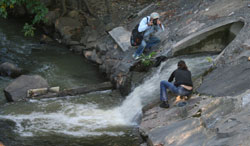
4.4 million gallons of sewage flowing into the Saw Mill River
Photo courtesy of Bard Porchaska
|
If you received this email from a friend and would like to be added to our Water Quality email list, send your contact information to us at info1@riverkeeper.org.
Sincerely,

John Lipscomb
Riverkeeper patrol boat "R. Ian Fletcher"
Highlights
These two months were textbook sampling runs illustrating water quality in DRY vs. WET weather. September was dry; there was almost no rain prior to and during our sampling patrol, so 9 of 75 samples had "unacceptable" Enterococcus (Entero) counts (12% "unacceptable" – the 2nd ‘best’ month this year). Something other than rain caused the 9 “unacceptable” samples.
By comparison, October was a whopper; it rained hard the night before the patrol started and there was more regional rain midway through (days 3 & 4 of 5), so 45 of 79 samples had “unacceptable” Entero counts (57% "unacceptable" – the ‘worst’ month this year by a large margin). In addition, it turns out that there was a 4.4 million gallon release of raw sewage at Sleepy Hollow and Yonkers while we happened to be sampling, which caused some foul water quality at those two locations.
Also in October, we took advantage of the opportunity to measure rain impacts at Beacon and Newburg by sampling just before and just after an all-night rain. Read on…..
September Observations
• NY Harbor (day 1): Every single sample location tested “acceptable.” Shows that in dry weather, the system around NYC works pretty well at keeping microbes out of the river and harbor. That’s good.
• Yonkers to Peekskill (day 2): Only upper Sparkill Creek in Orangetown and Cedar Pond Brook in Haverstraw/Stony Point had “unacceptable” Entero counts. Both tributaries are in Rockland County. Our sampling at Sparkill Creek shows chronically poor water quality, so unfortunately no surprise there, but Cedar Pond Brook has been better; “acceptable” every time we sampled in 2009 (a wet year), and yet, this year (drier) we’ve found 2 out of 6 “unacceptable” - seems like a location where something other than rainwater overflows and infiltration are to blame.
• Bear Mountain to Kingston (day 3): “Unacceptable” Entero counts at three sites: the West Point Sewer Plant discharge, Little Stony Point Beach and the Kingston Public Dock. Kingston is no surprise, our samples have been 50% “unacceptable” there this year and 2009 was worse. But there is something interesting about the other two. We started sampling BOTH in May 2008 and collected no “unacceptable” samples at EITHER in 2008 or 2009. However, this year BOTH were “unacceptable” on the same days in July and September and BOTH were higher when sampled in September. What’s up?
• Ulster Landing Beach to Waterford (day 4): “Unacceptable” counts at Island Creek, Dunn Memorial Bridge, and Albany Rowing Dock. This year, in spite of a pretty dry year, our samples were “acceptable” at these three sites only in May and August. The Mohawk River was REALLY ‘unacceptable” in September, the Entero count was >2,420 per 100ml (we can’t measure higher w/o doing a dilution). That’s the highest we’ve measured there this year and it was a beautiful dry weather day. So even a savvy person who knows to avoid contact with the water after wet weather could still at be at risk. In fair weather I see Jet Ski riders here. They have no way of knowing the water quality conditions. Russian roulette.
October Observations
• NY Harbor (day 1):
There was heavy rain the night before we sampled so EVERY sample we collected in the Harlem River, East River, Newtown Creek and Hudson River south of the GW Bridge had “unacceptable” Entero counts (over 104 per 100ml), with one exception – the effluent from the sewage treatment plant outfall at 125th Street. That’s right, the outflow from the sewage treatment plant tested better than the river it was flowing into.
• Yonkers to Peekskill (day 2): All sites were “acceptable” except three. Upper Sparkill Creek, where we’ve had only two acceptable counts this year (even though we sample more often there – about 4 times a month). At the mouth of the Saw Mill River we measured 816/100 ml and at Tarrytown Marina we got >24,200/100ml (over our maximum measurement limit in marine waters). Both locations smelled like crap when we arrived to sample. Surprise...turns out that there had been a 4.4 million gallon sewage spill caused by the failure of a high-pressure sewer main at Tarrytown the day before. The spilled sewage was released to the Hudson from a pipe next to the kayak launch and beach near Ichabod’s Landing condos in Sleepy Hollow and it was still pouring into the Saw Mill from a pipe in Yonkers. We didn’t know about this massive spill because the public wasn’t alerted.
Why should the public be warned about sewage spills like this? Well, the next day, with sewage still flowing into the Saw Mill and Hudson, 20 kids were down at the Beczak Center, just north of the Saw Mill, physically in the water sampling and seining, celebrating the Hudson along with thousands of other kids up and down the river on the annual “DAY IN THE LIFE” event. Who says that Westchester officials can just decide to keep a sewage spill like this from the public? It’s really wrong. Read more about this spill.
• Bear Mountain to Beacon (day 3): All sites tested “acceptable” (under 33/100ml) except for the Newburg Launch Ramp - which is par for the course more often than not this year (last year too). It was rain free during sampling.
• Beacon to Catskill (day 4): We had moderate rain all night between day 3 and 4, so I re-sampled Beacon and Newburg before continuing north.
Beacon: (before rain) 56/100ml “possible risk”
(after rain) 816/100ml “unacceptable” (threshold is 61/100ml in fresh water)
Newburg: (before rain) 326/100ml “possible risk”
(after rain) >2420/100ml “unacceptable” (measurement limit for fresh water)
It seems safe to say that both sites are clearly affected by rain events and that, in addition, Newburg has some dry weather sewage discharges.
The rest of the samples between Beacon and Catskill indicated spotty areas of contamination. Generally, the closer a sample was taken to the main stem of the river, the lower the Entero count. Samples taken in the tributaries, or near shore confined waters, were generally more contaminated. The message here is that we, on shore, are the source. Generally, out in the body of the river, farther from the sources, dilution lowers the contamination levels.
• Catskill Creek to Waterford (day 5): All 17 samples were “unacceptable.” (Entero over 61/100 ml). Several sites were above 600/100ml, several were above 900/100ml, several above 1900/100ml and two were above our ability to measure at >2420/100ml.
Poor water quality, real poor.
View sampling data sorted historically by individual sampling location.
View archived monthly water quality reports from May 2010 to the present.
September 2010 Sampling Data
For River Mile 0 to River Mile 44, the following standards apply:

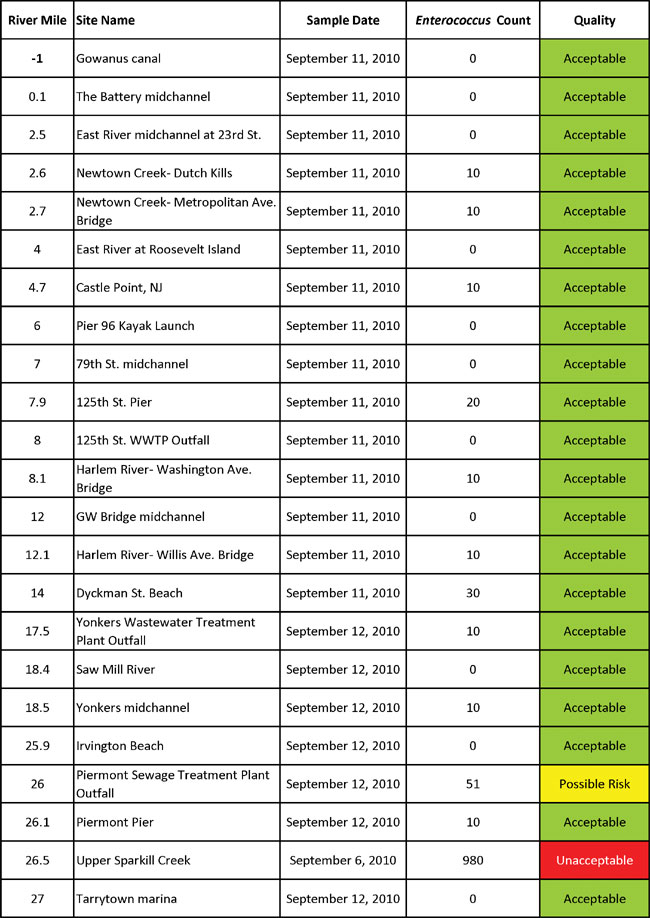
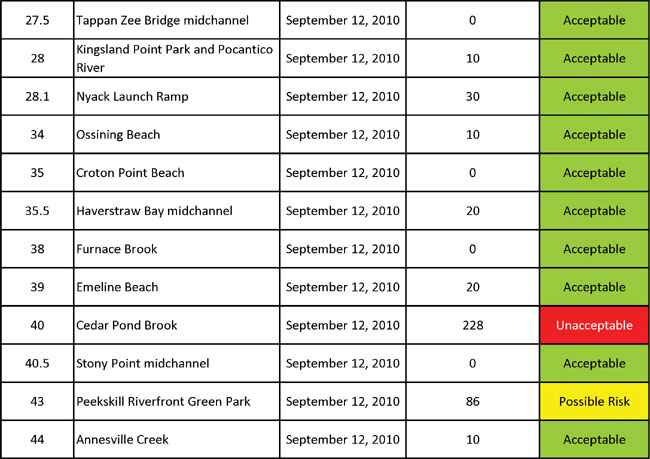
For River Mile 45 north, the following standards apply:

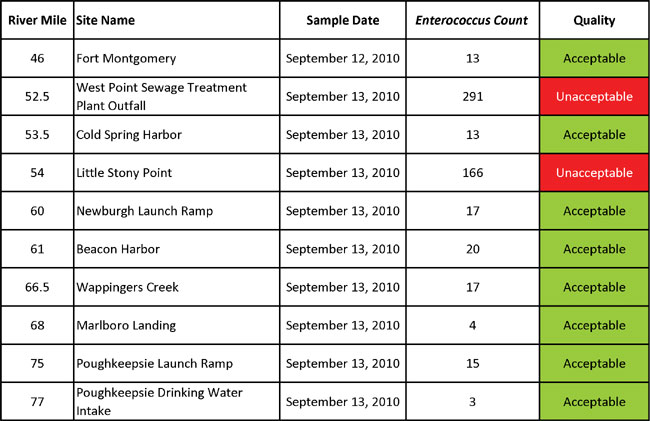
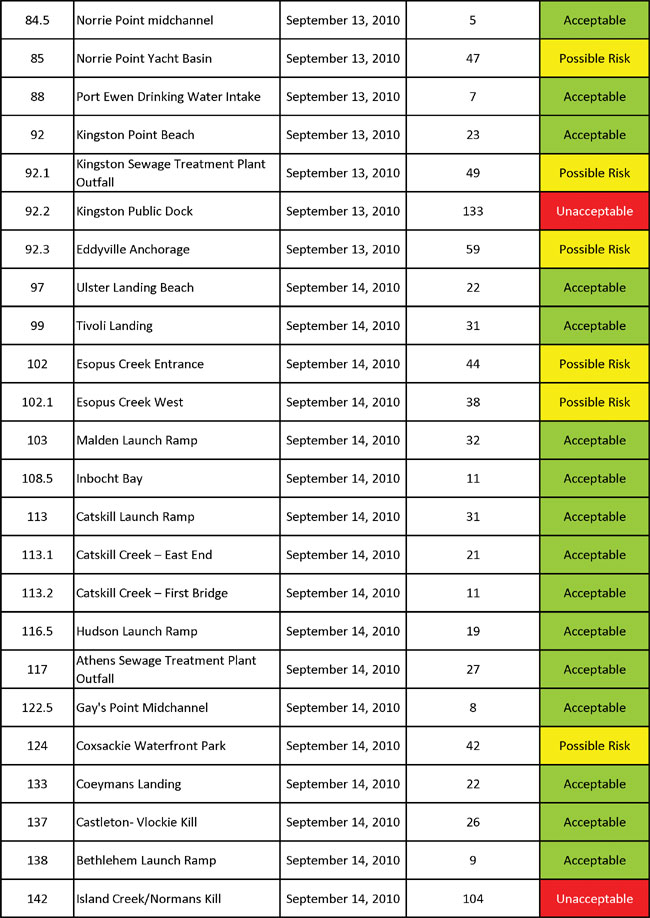

October 2010 Sampling Data
For River Mile 0 to River Mile 44, the following standards apply:

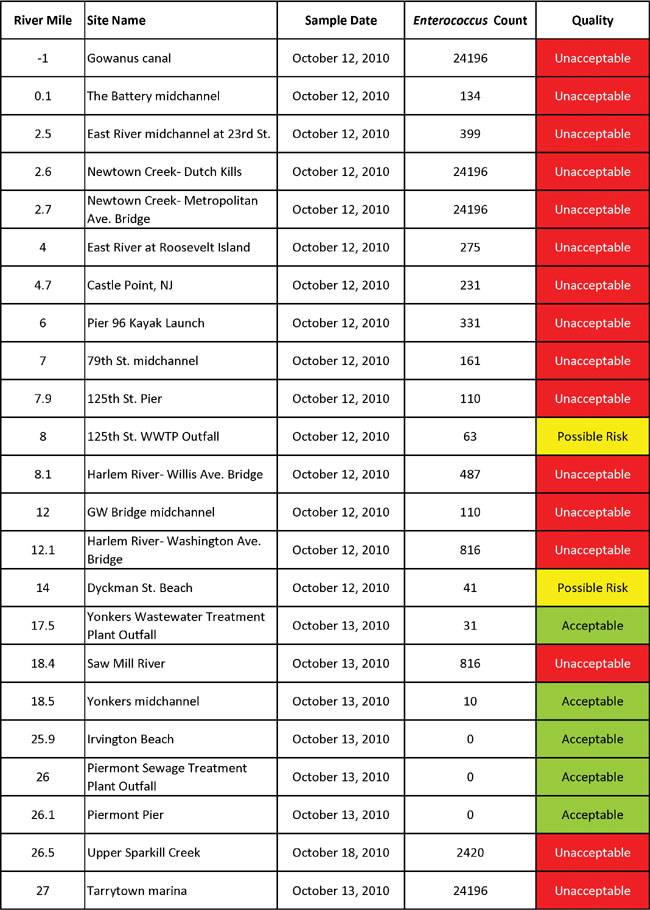
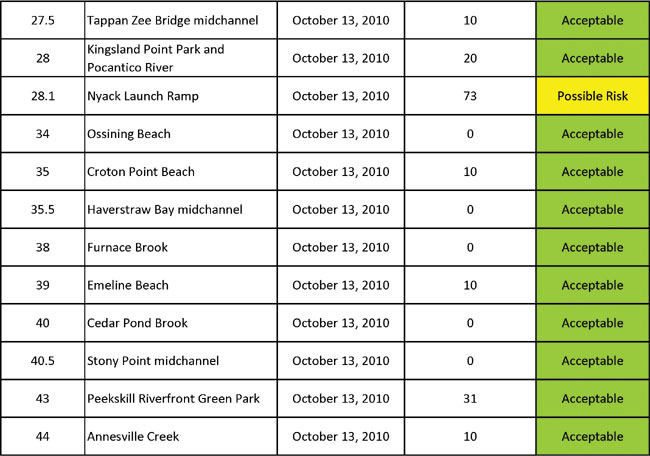
For River Mile 45 north, the following standards apply:


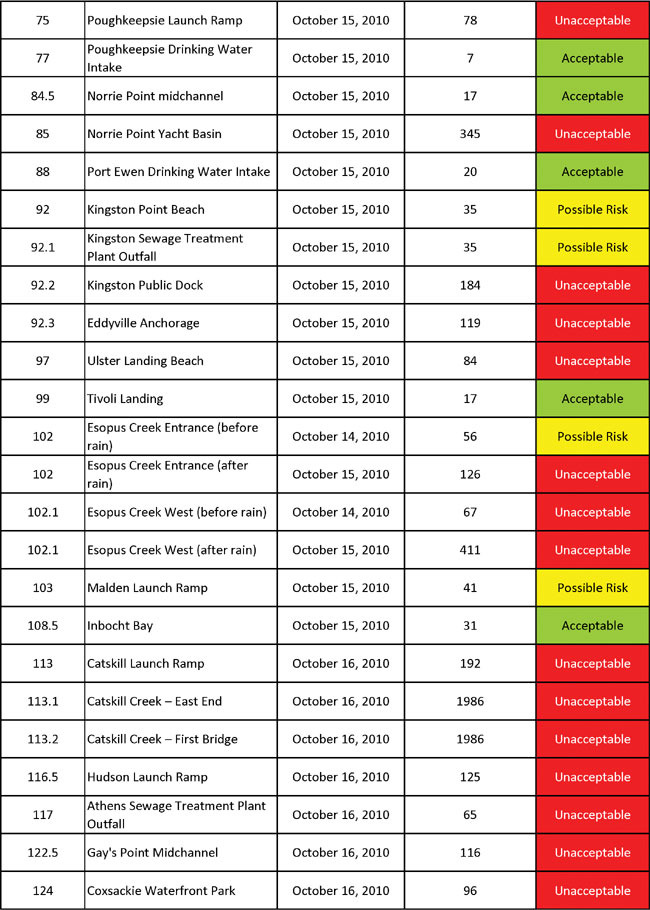

To learn more about Riverkeeper’s Water Quality Program, and to view historic sampling data, please visit www.riverkeeper.org/water-quality/hudson.
View previous months water quality report (August 2010-PDF).

|
















